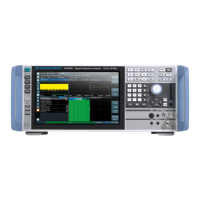General Instrument Setup
R&S
®
FSVA3000/ R&S
®
FSV3000
561User Manual 1178.8520.02 ─ 01
12 General Instrument Setup
Access: [SETUP]
Some basic instrument settings can be configured independently of the selected oper-
ating mode or application. Usually, you will configure most of these settings initially
when you set up the instrument according to your personal preferences or require-
ments and then only adapt individual settings to special circumstances when neces-
sary. Some special functions are provided for service and basic system configuration.
Network and Remote Settings, Display Settings
Settings for network and remote operation are described in Chapter 13, "Network and
Remote Operation", on page 644.
Display settings are described in Chapter 12.2.1, "Display Settings", on page 567.
● Alignment.............................................................................................................. 561
● Display Settings.................................................................................................... 567
● Event-based Actions............................................................................................. 580
● Application Starter.................................................................................................590
● Transducers.......................................................................................................... 592
● Frequency Response Correction (R&S FSV/A-K544)...........................................604
● Reference Frequency Settings..............................................................................614
● System Configuration Settings..............................................................................617
● Service Functions..................................................................................................625
● Synchronizing Measurement Channel Configuration............................................632
12.1 Alignment
12.1.1 Basics on Alignment
When you put the instrument into operation for the first time or when strong tempera-
ture changes occur, align the data to a reference source (see "Temperature check"
on page 562).
The correction data and characteristics required for the alignment are determined by
the firmware. It compares the results at different settings with the known characteristics
of the high-precision calibration signal source at 64 MHz.
Depending on the installation settings, an automatic self-alignment is performed
directly after installation, and a dialog is displayed indicating how much warm-up time
is still required before self-alignment can be performed.
Alignment

